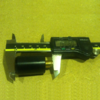You really need a way to measure the amount you are moving that shoulder.
+1. Without the ability to measure what you are doing, you really don't know what you are doing to the case, and then the discussion rapidly drifts into philosophical arguments.
I will agree and affirm that you will be better off full length resizing your cases and setting your dies up with cartridge headspace gages. I am of the opinion that neck sizing is a very profitable fraud for the industry. In time, your cases will be over length and you will have to knock them out with a cleaning rod. Neck sized ammunition will not necessarily be interchangeable between rifles.
Having cartridge headspace gages and using them to set up your dies means ammunition will chamber and extract properly from the other rifles you own, or may own. It also means that the ammunition will chamber after multiple resizing. I am currently shooting up my oldest ammunition, just this week shot up around 80 -120 rounds of 6.5 Swede ammunition. I sized this ammunition before I purchased cartridge headspace gages. Some of this ammunition was a couple of decades ago, and had been loaded that long. I set up my sizing dies based on Swedish service rifle chambers. Size a case, put it in the rifle, see if there is resistance to closing. It turns out service rifle chambers are huge and getting those cases into this M70 required hitting the bolt handle with my palm. I believe my case lubrication was the primary reason I did not have to use a cleaning rod to knock any cases out, but, have oversized cases that are large enough, no lube in the world is going to prevent that. New cases fed in great, came out great.

These CBC cases were hard to chamber, and I had cracked case necks because the stuff had been loaded so long.

Same issue here, hard to chamber, cracked case necks, don't know if they were responsible for the nines, nines happen.





